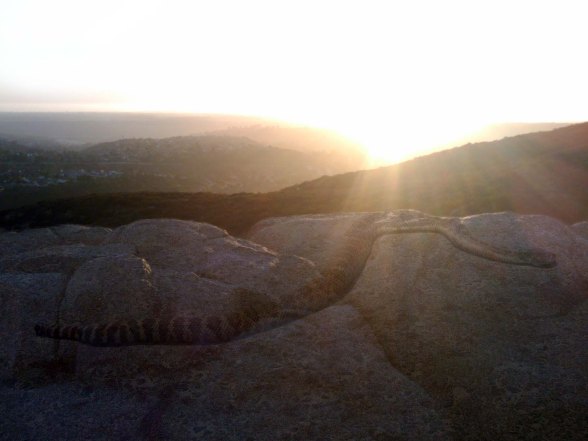It’s been so hot in San Diego this summer that the last thing that I want to do is go for a hike in the middle of the day. Since I am not a morning person…at all…mornings are simply out of the question. So I’ve been waiting until evening and sometimes until after dark when the air has cooled down. It is surprisingly peaceful hiking at night and so much cooler! A few days ago, I decided to hike a popular hiking trail in San Diego called Cowles Mountain, which has a 1,593 ft summit. The summit reveals a 360-degree view of San Diego and you can even see as far as Mexico. This trail is always swarming with hikers and runners. During the day, the hundreds of hikers mimic worker ants marching in an ant farm. At night, the flickering of flashlights remind me of lightning bugs dancing on the black silhouette of a mountain.
I started the ascent at about 9:00 pm, carrying a water bottle, keys, and my cell phone. I ran into a handful of people on my way up, surprisingly most of them were walking in the dark without a flashlight. I thought that they must have lost track of time. The night air was shockingly warm as I arrived at the summit. The view was stunning at night with city lights surrounding the mountain. I looked out and could see skyscrapers downtown and even the famous Coronado Bridge lit up. The horizon line had a slight orange glow from all of the light pollution and the stars…well you don’t live in San Diego for the stars. All I could hear was a neighborhood dog howling and the occasional car passing below. As I started my descent, I saw the silhouette of a bat twirling in the air as if he was an aircraft at a Blue Angel Air Show. I passed a guy wearing a hoodie, who also did not have a flashlight and made a comment about him being brave in the darkness due to all of the rocks you could easily trip over. I continued down the trail with my beam from my flashlight bouncing off rocks and bushes. All of the sudden, I heard a rattle and a breathing noise. I immediately froze and in the middle of the trail there was a rattlesnake coiled up with its head out ready to strike approximately 2-3 ft away. Confused at the presence of a rattlesnake at 10:30 pm, I shined my light at it and it seemed to agitate it more. At that moment, I felt an overwhelming feeling of respect for the creature. So I slowly started walking backwards. There was a wooden guardrail on one side and dry bushes on the other side of the trail. Realizing there was no way for me to safely walk by the rattlesnake, I searched for a detour trail and safely found my way back down the mountain. I felt relieved and lucky but confused at the presence of the snake at the same time. After researching and speaking with a friend who use to work for the Sequoia National Park, this is what I found out…
Why was a rattlesnake out on a main trail at 10:30 at night? I thought that rattlesnakes came out during the day to bask in the sun due to them being cold blooded?
As the weather gets hotter, snakes will be more nocturnal. So they’ll be less active during daylight, and more active at dusk, night and dawn.
What can I do to protect myself from being bit?
- Be aware of your surroundings
- Wear high top shoes/boots
- Wear heavy-duty type pants if you can
- Bring a good flashlight if hiking at night
- Bring a walking stick
- Stick to the main trail
If I had been bit, what should I have done?
- Remain calm so as not to increase circulation and thus the spread of the venom.
- Immediately remove anything from the body that may cause increased swelling below the bite area (i.e., rings, watch, shoes, tight clothing, etc.)
- If possible, wash the wound with soap and water. If available, a Sawyer Extractor Pump may be used to remove some of the venom. Be familiar with the procedure and instructions before you need to use it.
- Immobilize the bite area, keeping it in a neutral to below the heart position.
- Get to the hospital immediately. Do not wait for the pain to get severe. The use of approved antivenom is the most effective treatment for envenomation. If possible, have another person drive, and call ahead to the hospital and the poison center.
I thought you were supposed to make a cut and suck out the venom?
No! Do not make an incision or try to suck out the venom.
